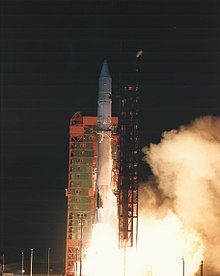 Launch of FLTSATCOM-7 on an Atlas G (AC-66). | |
| Function | Expendable launch system |
|---|---|
| Manufacturer | Convair General Dynamics |
| Country of origin | United States |
| Size | |
| Height | 43.90m (144.00 ft) |
| Diameter | 3.05m (10 ft) |
| Mass | 164,300kg (362,200 lb) |
| Stages | 2.5 |
| Capacity | |
| Payload to 185 km (115 mi) LEO | |
| Mass | 5,900 kg (13,000 lb)[1] |
| Payload to GTO | |
| Mass | 2,375 kg (5,236 lb)[2] |
| Associated rockets | |
| Family | Atlas |
| Launch history | |
| Status | Retired |
| Launch sites | LC-36B, Cape Canaveral |
| Total launches | 7 |
| Success(es) | 5 |
| Failure(s) | 2 |
| First flight | 9 June 1984 |
| Last flight | 25 September 1989 |
| Boosters – MA-5[3] | |
| No. boosters | 1 |
| Powered by | 2 LR-89-7 |
| Maximum thrust | 1,901.6 kN (427,500 lbf)[3] |
| Specific impulse | 293.4 s (2.877 km/s) |
| Burn time | 155 seconds[2] |
| Propellant | RP-1 / LOX |
| First stage | |
| Powered by | 1 LR-105-7 |
| Maximum thrust | 386.4 kN (86,900 lbf)[3] |
| Specific impulse | 316 s (3.10 km/s) |
| Burn time | 266 seconds[2] |
| Propellant | RP-1 / LOX |
| Second stage – Centaur | |
| Powered by | 2 RL-10A |
| Maximum thrust | 147 kN (33,000 lbf) |
| Specific impulse | 449 s (4.40 km/s) |
| Burn time | 410 seconds[2] |
| Propellant | LH2 / LOX |
The Atlas G, also known as Atlas G Centaur-D1AR[4][5] was an American expendable launch system derived from the Atlas-Centaur. It was a member of the Atlas family of rockets and was used to launch seven communication satellites during the mid to late 1980s. Atlas G consisted of an improved Atlas core with modernized avionics and stretched propellant tanks. The Centaur stage also had several updated components and other technical improvements. Atlas G flew 7 times, with all missions aiming to go to a geostationary transfer orbit. It was replaced by the near-identical Atlas I, which had an improved guidance system and offered a larger payload fairing.
- ^ Gunter D. Krebs. "Atlas-1 (Atlas I)". Gunter's Space Page. Retrieved 17 July 2022.
- ^ a b c d General Dynamics (April 1992). "Atlas Mission Planner's Guide". Retrieved 17 July 2022.
- ^ a b c Norbert Brügge. "Variants of the "stage and a half" drive system (MA) of the Atlas rocket". Archived from the original on 20 January 2016. Retrieved 17 July 2022.
- ^ "Atlas-G Centaur-D1AR". Gunter's Space Page. Retrieved 2024-01-01.
- ^ Cite error: The named reference
slrwas invoked but never defined (see the help page).